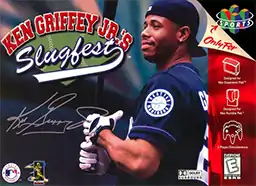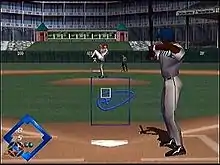Ken Griffey Jr.'s Slugfest
Ken Griffey Jr.'s Slugfest is a baseball game for the Nintendo 64 and Game Boy Color, featuring real-life player Ken Griffey Jr. It was released in 1999. It is a sequel to Major League Baseball Featuring Ken Griffey Jr., released for the Nintendo 64, which itself was a sequel to Ken Griffey Jr. Presents Major League Baseball and Ken Griffey Jr.'s Winning Run, both released for the Super NES.
| Ken Griffey Jr.'s Slugfest | |
|---|---|
 North American Nintendo 64 cover art | |
| Developer(s) | Angel Studios (N64) Software Creations (GBC) |
| Publisher(s) | Nintendo |
| Platform(s) | Game Boy Color, Nintendo 64 |
| Release | Nintendo 64
|
| Genre(s) | Sports |
| Mode(s) | Single-player, multiplayer |
This version of the game contains actual player names, unlike the original. It contains Season, Exhibition, World Series and Home Run Derby modes. It also has familiar background music playing throughout the game.
Gameplay

The batting feature in this game is set up differently from most other baseball video games. The batter is given an elongated oval shape to control and in order for the batter to make contact with the ball, he must wait for the pitch location and then move the oval to the location of the pitch to make contact. Each batter will have a different sized oval or hitting zone depending on how strong of a hitter he is. This feature was originally developed in Major League Baseball Featuring Ken Griffey Jr. and carried over into this game with slight modifications.
The fielding portion of this game makes use of the c-directional pad on the Nintendo 64 controller. As a fielder, you must run to the ball using the analog stick and then choose the correct c-button for the base to which you would like to throw. The controller has four c-buttons: c-up, c-left, c-right, and c-down and each of these represent a different base. Each c-button represents the base that would correspond with its location on the controller. For example, c-right represents first base, c-up represents second base, c-left represents third base, and c-down represents home plate.
This game uses simple controls for pitching that are very similar to the controls of other baseball video games of the time. Before the pitch, there will be a menu that will show all available pitches that the pitcher can throw. In order to throw a certain pitch, you must press the button that is next to the pitch you would like to throw. The strike zone will be shown by a white rectangular box and any pitch that is located in the box will be a strike. Also, while the ball is being thrown, the pitcher may use the analog stick to move the pitch in any direction. There are several different pitches that can be thrown. They are: fastball, super fastball, change up, super change up, knuckleball, curveball, slider, and screwball. Every pitcher has his own unique set of pitches and no pitcher can throw all the pitches. The speed of the pitches can range anywhere from 37 mph to 103 mph.
This game allows the player to select pitchers of a team from the bullpen or rotation. This game also allows the player to select different pitches to be thrown, based on each real life pitchers' abilities. The player of this game may create custom baseball players with different pitches, size, strength, and stamina. The player may also select the team, stadium, and choose between day or night and home or away games.
Reception
| Aggregator | Score | |
|---|---|---|
| GBC | N64 | |
| GameRankings | 57%[1] | 77%[2] |
| Publication | Score | |
|---|---|---|
| GBC | N64 | |
| AllGame | N/A | |
| EGM | N/A | 6.75/10[4] |
| Game Informer | 5.25/10[5] | 8.5/10[6] |
| GamePro | N/A | |
| GameRevolution | N/A | B−[8] |
| GameSpot | N/A | 7.8/10[9] |
| Hyper | N/A | 81%[10] |
| IGN | 4/10[11] | 7.9/10[12] |
| Next Generation | N/A | |
| Nintendo Power | 7.3/10[14] | 7.7/10[15] |
| The Cincinnati Enquirer | N/A | |
The Nintendo 64 version received favorable reviews, while the Game Boy Color version received mixed reviews, according to the review aggregation website GameRankings.[1][2] Next Generation called the former version "one of the best arcade baseball titles in a while. Sure, the graphics pale in comparison to Acclaim's All-Star Baseball 2000, and realism is notably absent, but if you're more concerned about white-knuckled multiplayer games and .500 batting averages than pitching duels and squeeze plays, this is your game."[13]
References
- "Ken Griffey Jr.'s Slugfest for Game Boy Color". GameRankings. CBS Interactive. Archived from the original on May 4, 2019. Retrieved October 18, 2020.
- "Ken Griffey Jr.'s Slugfest for Nintendo 64". GameRankings. CBS Interactive. Archived from the original on May 4, 2019. Retrieved October 18, 2020.
- Cook, Brad. "Ken Griffey Jr.'s Slugfest (GBC) - Reviews". AllGame. All Media Network. Archived from the original on November 14, 2014. Retrieved October 18, 2020.
- EGM staff (July 1999). "Ken Griffey Jr's Slugfest (N64)". Electronic Gaming Monthly. No. 120. Ziff Davis. p. 125. Retrieved October 18, 2020.
- Reiner, Andrew (September 1999). "Ken Griffey Jr.'s Slugfest - Game Boy Color". Game Informer. No. 77. FuncoLand. Archived from the original on October 25, 2000. Retrieved October 18, 2020.
- Anderson, Paul (July 1999). "Ken Griffey Jr.'s Slugfest (N64)". Game Informer. No. 75. FuncoLand. p. 62. Archived from the original on May 26, 2000. Retrieved October 18, 2020.
- The Rookie (August 1999). "Ken Griffey Jr.'s Slugfest (N64)". GamePro. No. 131. IDG Entertainment. p. 99. Retrieved October 18, 2020.
- Dr. Moo (June 1999). "Ken Griffey Jr.'s Slugfest Review (N64)". GameRevolution. CraveOnline. Archived from the original on September 10, 2015. Retrieved October 18, 2020.
- MacDonald, Ryan (May 27, 1999). "Ken Griffey Jr.'s Slugfest Review (N64) [date mislabeled as "April 28, 2000"]". GameSpot. CBS Interactive. Archived from the original on March 8, 2005. Retrieved October 18, 2020.
- Norton-Smith, Hugh (August 1999). "Ken Griffey Jr. Slugfest [sic] (N64)". Hyper. No. 70. Next Media Pty Ltd. pp. 62–63.
- Harris, Craig (August 18, 1999). "Ken Griffey Jr.'s Slugfest (GBC)". IGN. Ziff Davis. Retrieved October 18, 2020.
- Boulding, Aaron (May 7, 1999). "Ken Griffey Jr.'s Slugfest (N64)". IGN. Ziff Davis. Retrieved October 18, 2020.
- "Ken Griffey Jr.'s Slugfest (N64)". Next Generation. No. 56. Imagine Media. August 1999. p. 90. Retrieved October 18, 2020.
- "Ken Griffey Jr.'s Slugfest (GBC)". Nintendo Power. Vol. 122. Nintendo of America. July 1999. p. 118.
- "Ken Griffey Jr.'s Slugfest (N64)". Nintendo Power. Vol. 121. Nintendo of America. June 1999. p. 109. Retrieved October 18, 2020.
- Bottorff, James (1999). "Griffey's Slugfest a hit for casual baseball fans". The Cincinnati Enquirer. Gannett Company. Archived from the original on August 27, 1999. Retrieved October 18, 2020.